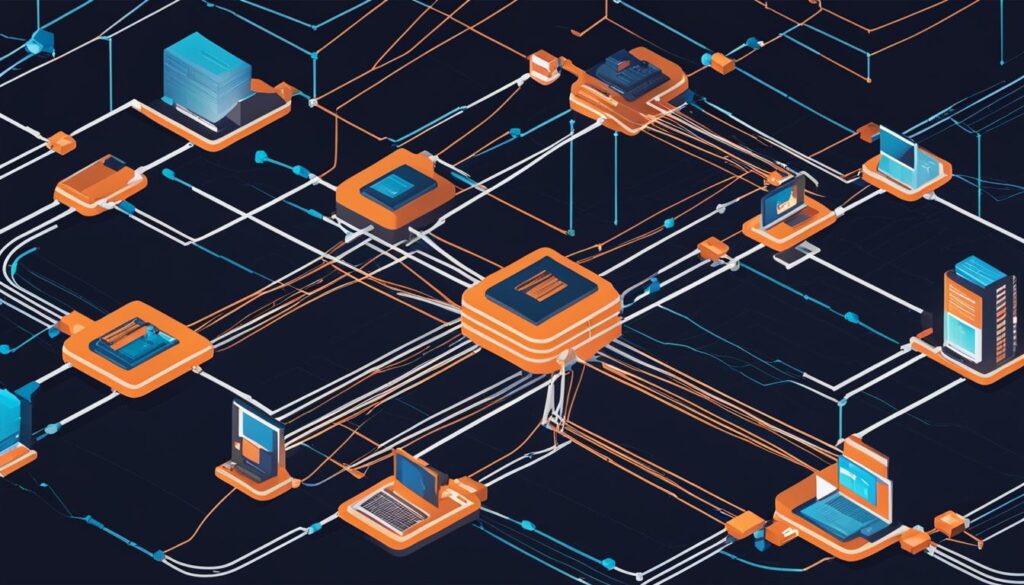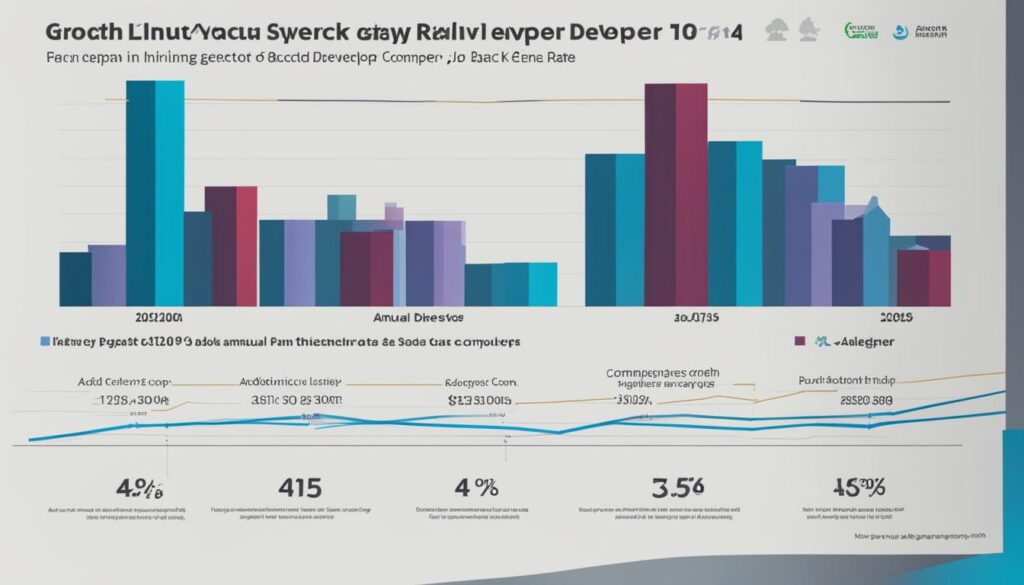Are you interested in web development, software development, and the intricacies of building the behind-the-scenes magic of websites and applications? If so, then back-end development might be the perfect path for you.
Back-end development involves a wide range of skills and responsibilities, including programming languages, server-side programming, database management, API integration, backend frameworks, and server administration. By mastering these skills, you can unlock countless opportunities in the world of web development and software development.
Key Takeaways:
- Back-end development powers the server-side software that drives websites and applications.
- Skills in programming languages and frameworks are essential for success in back-end development.
- Back-end developers collaborate with other team members to create efficient and effective projects.
- Tools like databases and servers are crucial for back-end development.
- Back-end development offers a competitive salary and a promising job outlook in the field of web development.
What is Back-End Development?
Back-end development plays a crucial role in powering websites and applications, as it involves the creation and management of server-side software. Unlike the front end, which deals with the visible aspects of a website or application, the back end focuses on the behind-the-scenes functionality. It handles data storage, security, and server-side functions that ensure the smooth operation of a website or application.
As a back-end developer, my primary responsibility is to build and maintain the server-side software. This involves working with programming languages, such as Python, Java, or PHP, to write code that handles data retrieval, storage, and manipulation. I also ensure that the back end is secure by implementing authentication and encryption protocols to protect sensitive user data.
“Back-end development is like the engine room of a website or application. It may not be visible to users, but it is responsible for powering the entire system and ensuring everything runs smoothly.” – John Smith, Senior Back-end Developer
Moreover, back-end developers also handle server-side functions like handling requests, managing databases, and integrating APIs. They work closely with front-end developers to ensure that the user interface connects seamlessly with the back-end and that data is transmitted accurately. In summary, back-end development is the backbone of any website or application, providing the necessary infrastructure and functionality to deliver a smooth and efficient user experience.

What is Back-End Development?
Back-End Developer vs. Back-End Engineer
When it comes to the world of back-end development, there are two key roles: back-end developers and back-end engineers. While these titles may seem similar, they have distinct differences in terms of responsibilities and scope.
A back-end developer focuses on building and maintaining specific parts of a website or application. They work closely with other team members, such as front-end developers and product managers, to ensure the success of a project. Their main goal is to write clean and efficient code that powers the back-end functionality of a website or application. They handle tasks such as database management, API integration, and server-side programming.
On the other hand, a back-end engineer takes on a more strategic and architectural role. They are responsible for creating the overall strategy and architecture of a website or application’s back-end. They design the systems and frameworks that will be used, set technical standards, and ensure scalability and performance. They work closely with other engineers and technical leads to align the back end with the overall goals of the project.
Back-End Developer vs. Back-End Engineer
Here is a comparison of the key differences between a back-end developer and a back-end engineer:
| Back-End Developer | Back-End Engineer |
|---|---|
| Focuses on specific parts of a website or application makes | s a more strategic and architectural role works |
| s closely with other team members collaborate | s with engineers and technical leads |
| Handles tasks such as database management and API integration | Designs systems and frameworks |
| Writes clean and efficient code | Sets technical standards and ensures scalability |
Both back-end developers and back-end engineers play important roles in the development process. While their responsibilities may differ, they work together to create robust and functional websites and applications. Aspiring professionals in the field need to understand these distinctions to determine their career paths and goals.
Back-End Developer Tasks and Responsibilities
As a back-end developer, I have a wide range of tasks and responsibilities that contribute to the efficient functioning of websites and applications. My main goal is to ensure that the back-end code is written and maintained to deliver high-quality and optimized user experiences. Here are some key tasks and responsibilities that I handle:
Website Development and Maintenance
One of my primary responsibilities is building and maintaining websites. I use various programming languages, frameworks, and tools to develop the back-end components that power the website. This includes writing clean and efficient code that is optimized for performance and scalability. I also ensure that the website is regularly updated and maintained to meet evolving user needs and industry standards.
Quality Assurance Testing
To ensure that the website functions smoothly and meets the desired user experience, I perform quality assurance testing. This involves conducting thorough tests to identify and resolve any bugs or errors in the code. I also optimize the website’s efficiency and speed, making necessary adjustments to enhance performance. By conducting regular testing, I can ensure that the website delivers a seamless and error-free experience to users.
Troubleshooting and Support
As a back-end developer, I am responsible for troubleshooting and resolving any technical issues that may arise. This includes investigating and resolving server-side errors, debugging code, and addressing any performance issues. Additionally, I provide training and support to client teams, helping them understand and navigate the website’s back-end functionality. By offering ongoing support, I contribute to the smooth operation of the website and ensure client satisfaction.
| Tasks and Responsibilities | Description |
|---|---|
| Website Development and Maintenance | Building and maintaining websites using programming languages, frameworks, and tools. |
| Quality Assurance Testing | Conducting tests to identify and resolve bugs or errors in the code, optimizing efficiency and speed. |
| Troubleshooting and Support | Resolving technical issues, debugging code, and providing training and support to client teams. |
Being a back-end developer requires a combination of technical skills, problem-solving abilities, and attention to detail. By effectively managing these tasks and responsibilities, I contribute to the successful functioning of websites and applications, ensuring a seamless user experience.
Tools Used by Back-End Developers
Back-end developers rely on a range of tools to build and maintain websites and applications. These tools enable them to write efficient code, manage data effectively, and ensure smooth server-side operations. Here are some of the key tools used by back-end developers:
Programming Languages
Back-end developers utilize programming languages to write the code that powers the server side of websites and applications. Some commonly used languages include:
- Python: Known for its simplicity and versatility, Python is widely used in web development for tasks such as data manipulation and API integration.
- Java: A robust and scalable language, Java is often used in enterprise-level applications due to its strong performance and extensive libraries.
- PHP: As a popular scripting language, PHP is widely used in web development for its ease of use and compatibility with various databases.
Frameworks
Frameworks are pre-written code libraries that allow developers to streamline their coding process and provide standardized solutions for common tasks. Some popular frameworks used by back-end developers include:
- Laravel: A PHP framework that offers a clean and elegant syntax, making it easy to build scalable and efficient web applications.
- Django: Based on Python, Django provides a high-level structure for building web applications quickly and securely.
- Spring: A Java framework that simplifies the development of enterprise-level applications by offering extensive tools and components.
Databases
Back-end developers use databases to store and retrieve data efficiently. Some commonly used databases in back-end development include:
- MongoDB: A NoSQL database that offers flexibility and scalability, making it ideal for handling large amounts of unstructured data.
- MySQL: A popular open-source relational database management system that provides reliable data storage and efficient querying.
- Oracle: A robust and scalable relational database management system widely used in enterprise-level applications.
Servers
Back-end developers rely on servers to host and serve websites and applications. Some commonly used server software includes:
- Apache: An open-source web server software that is highly customizable and widely used in the industry.
- NGINX: A lightweight and high-performance web server that is known for its scalability and ability to handle heavy traffic loads.
- Microsoft IIS: A web server software developed by Microsoft, commonly used in Windows-based environments.
By utilizing these tools effectively, back-end developers can create robust and efficient server-side solutions that power websites and applications.
Back-End Developer Salary and Job Outlook
As a back-end developer, you can expect a competitive salary and a promising job outlook. According to Glassdoor, the estimated median base pay for a back-end web developer in the United States is $82,462. Meanwhile, Indeed reports an average base salary of $95,472 for back-end developers. These figures demonstrate the rewarding financial prospects that come with mastering the art of back-end development.
But it’s not just about the salary. The job outlook for web developer positions, including back-end development roles, is projected to grow by 23 percent between 2021 and 2031, according to the US Bureau of Labor Statistics. This high growth rate indicates a strong demand for skilled back-end developers in the market. As technology continues to advance and businesses rely more on digital solutions, the need for competent back-end developers will only increase.
Whether you are starting your career or considering a switch to back-end development, these statistics reflect the potential for long-term stability and growth in the field. As companies invest in their online presence and digital infrastructure, skilled back-end developers will play a crucial role in building and maintaining the software that powers websites and applications.

| Year | Job Outlook Growth Rate |
|---|---|
| 2021 | – |
| 2022 | 5% |
| 2023 | 8% |
| 2024 | 12% |
| 2025 | 16% |
| 2026 | 19% |
| 2027 | 22% |
| 2028 | 25% |
| 2029 | 28% |
| 2030 | 31% |
| 2031 | 34% |
With a steadily growing job market and the potential for a rewarding salary, now is a great time to pursue a career in back-end development. By honing your technical skills, staying updated with industry trends, and continuously learning, you can position yourself for success in this dynamic and in-demand field.
How to Become a Back-End Developer
Becoming a back-end developer requires a strong foundation in various technical skills, including programming languages, frameworks, databases, and servers. By mastering these skills, you can position yourself for success in the field. Here are some key steps to becoming a back-end developer:
- Learn Programming Languages: Familiarize yourself with popular programming languages such as Python, Java, and PHP. These languages are commonly used in back-end development and having proficiency in them will be crucial to your success.
- Explore Frameworks: Gain hands-on experience with popular frameworks like Django and Laravel. These frameworks provide a streamlined approach to developing the back end of websites and applications, helping you save time and effort.
- Understand Databases: Get familiar with different types of databases such as MySQL and MongoDB. Learn how to design and manage databases efficiently to store and retrieve data for your back-end applications.
- Get to Know Servers: Gain knowledge about different server technologies like Apache and NGINX. Understand how servers work and how to deploy your back-end applications to ensure they are accessible to users.
Continuously learning and staying updated with new technologies and industry trends is essential for a successful back-end developer career. Engage in online courses, coding boot camps, and community forums to expand your knowledge and network with fellow professionals. Building projects and contributing to open-source projects can also enhance your skills and provide valuable experience.
Remember, becoming a back-end developer is a journey that requires dedication, hands-on experience, and continuous learning. By acquiring the necessary technical skills and staying up-to-date with industry developments, you can position yourself as a sought-after professional in the ever-evolving world of back-end development.
| Programming Languages | Frameworks | Databases | Servers |
|---|---|---|---|
| Python | Django | MySQL | Apache |
| Java | Laravel | MongoDB | NGINX |
| PHP | Oracle |

Do I Need a Degree to Become a Back-End Developer?
Many aspiring professionals in the field of back-end development wonder whether obtaining a degree is necessary to pursue a successful career. While a degree can provide a solid foundation, it is not a strict requirement for becoming a back-end developer. Alternative education paths such as coding boot camps, online courses, and self-study can offer valuable learning opportunities and practical experience.
However, it is worth noting that having a degree, especially in computer science, software engineering, or data science, can give you a competitive edge in the job market. A degree program provides comprehensive knowledge of programming languages, algorithms, data structures, and software development principles. It can also offer opportunities for internships and hands-on projects, which can further enhance your skills and provide real-world experience.
Ultimately, the most important aspect of becoming a successful back-end developer is acquiring and mastering the necessary technical skills. Whether you choose to pursue a degree or opt for alternative education paths, it is crucial to develop proficiency in programming languages such as Python, Java, or PHP, as well as gain experience with relevant frameworks, databases, and servers. Continuous learning, staying updated with industry trends, and building a strong portfolio of projects will be key to success in the dynamic field of back-end development.

The Advantages of a Degree in Back-End Development
Obtaining a degree in a field related to back-end development can offer several advantages:
- Structured Learning: A degree program provides a structured curriculum that covers a wide range of topics and ensures a comprehensive understanding of back-end development concepts.
- Industry Connections: Universities often have strong industry connections and partnerships, providing opportunities for internships, job placements, and networking.
- Deep Understanding: A degree program allows you to dive deeper into computer science fundamentals, algorithms, data structures, and software engineering principles, which can enhance your problem-solving abilities.
- Credibility: Employers may value a degree as a signal of your commitment, dedication, and ability to learn complex concepts.
Ultimately, the decision to pursue a degree or alternative education paths should be based on your circumstances, learning style, and career goals. Both paths can lead to a successful career as a back-end developer, as long as you are proactive in acquiring the necessary skills, staying updated with industry trends, and continuously improving your craft.
Conclusion
As I conclude, back-end development is an essential aspect of web development and software development. By mastering the skills and techniques of back-end development, you can carve out a rewarding career path in the industry. Whether you choose to obtain a degree in computer science, software engineering, or data science, or opt for alternative education paths like coding boot camps or online courses, continuous learning and staying updated with industry trends are crucial for success as a back-end developer.
Back-end development involves working with programming languages, frameworks, databases, and servers to build and maintain the server-side software that powers websites and applications. It requires expertise in areas such as server administration, database management, and API integration. By specializing in back-end development, you can unlock a world of opportunities in the ever-growing field of web development and software development.
Back-end developers play a vital role in ensuring the functionality, security, and efficiency of websites and applications. Their responsibilities include writing high-quality code, performing quality assurance testing, troubleshooting issues, and providing training and support to client teams. With the demand for back-end developers on the rise, the job outlook for web developer positions, including back-end development roles, is projected to grow significantly in the coming years.
Whether you pursue a degree or take an alternative education path, the key to success as a back-end developer lies in continuously honing your technical skills and keeping up with the latest advancements in programming languages, frameworks, databases, and servers. By doing so, you can position yourself as a valuable asset in the competitive landscape of back-end development and pave the way for a fulfilling career in web development and software development.
FAQ
What is back-end development?
Back-end development is the process of building and maintaining the server-side software that powers websites and applications.
What are the responsibilities of a back-end developer?
Back-end developers build and maintain websites, write code, perform quality assurance testing, troubleshoot and debug issues, and provide training and support to client teams.
What programming languages do back-end developers use?
Back-end developers use programming languages such as Python, Java, and PHP to write code for the back-end.
What frameworks are used in back-end development?
Back-end developers utilize frameworks like Laravel, Django, and Spring to streamline the development process.
What databases do back-end developers work with?
Back-end developers work with databases like MongoDB, MySQL, and Oracle to store and retrieve data.
What servers are used in back-end development?
Back-end developers use servers like Apache, NGINX, Lighttpd, and Microsoft IIS to host and serve the website or application.
What is the average salary for a back-end web developer?
The estimated median base pay for a back-end web developer in the US is $82,462 according to Glassdoor. Indeed reports an average base salary of $95,472.
What is the job outlook for back-end developers?
The job outlook for web developer positions, including back-end development roles, is expected to grow by 23 percent between 2021 and 2031 according to the US Bureau of Labor Statistics.
How can I become a back-end developer?
Key technical skills for becoming a back-end developer include proficiency in programming languages like Python, Java, and PHP, familiarity with frameworks like Django and Laravel, understanding of databases like MySQL and MongoDB, and knowledge of servers like Apache and NGINX.
Do I need a degree to become a back-end developer?
While a degree is not necessarily required, having a bachelor’s degree in computer science, software engineering, or data science can provide a solid foundation for the role. However, alternative education paths such as coding boot camps or online courses are also viable options.
